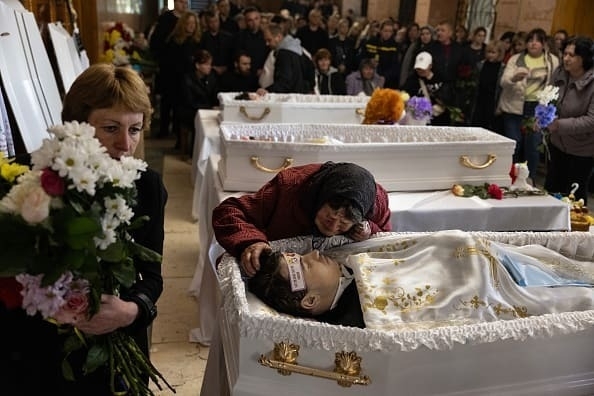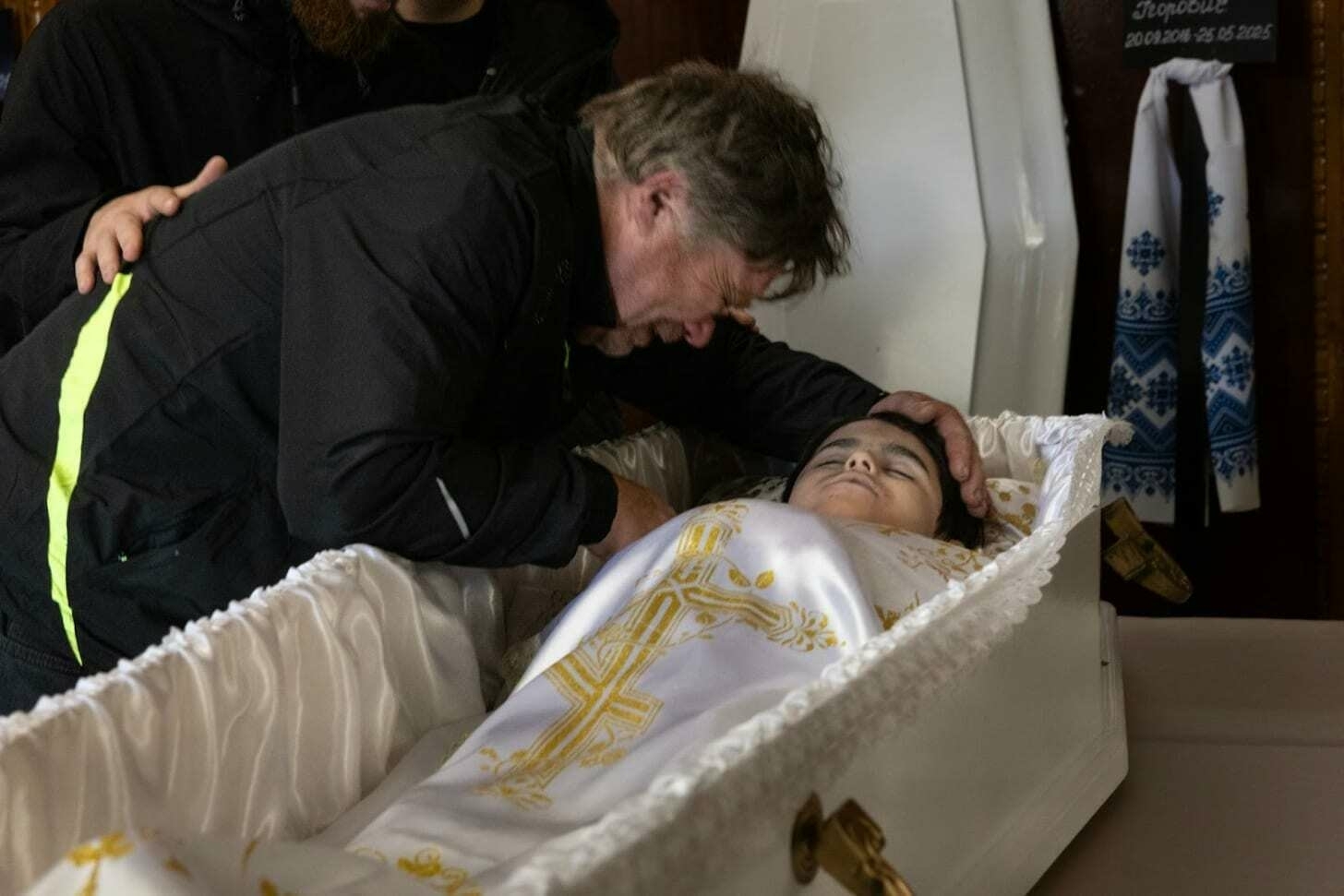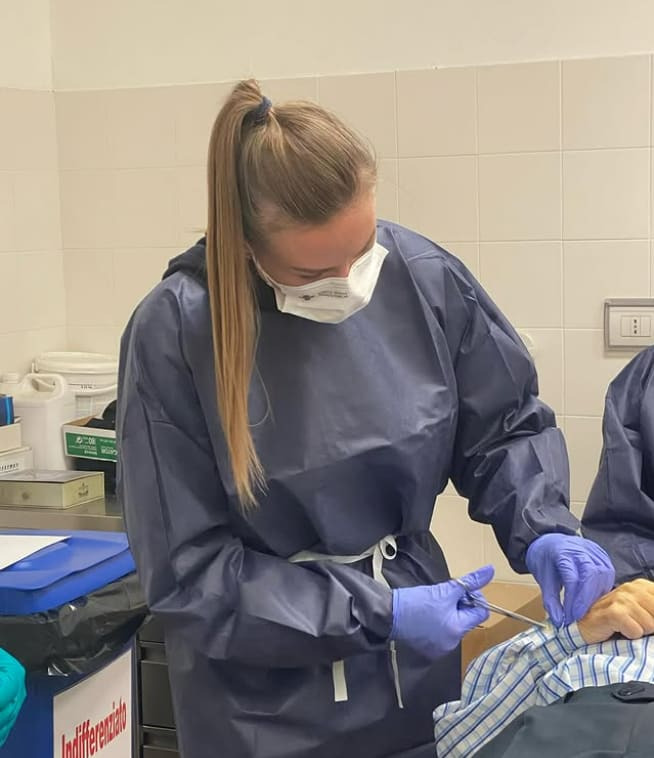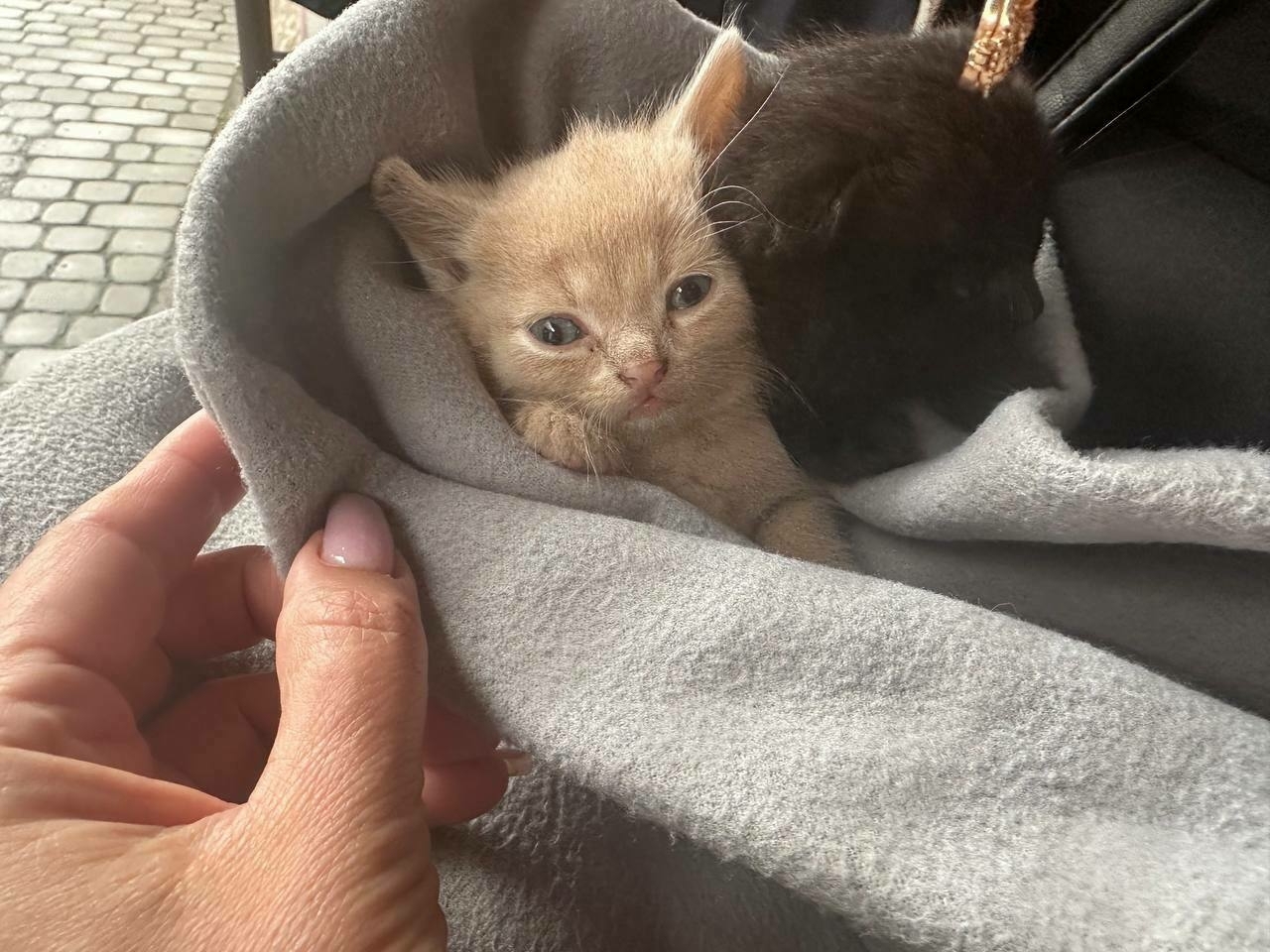Editor’s Note: We’re raising funds to get every member of The Counteroffensive team a sleeping bag, foldable cot, ear plugs and eye mask so they can get some sleep amid these dramatically increasing attacks in Kyiv.
We also cover every member of our team and their mental health therapy sessions. Support us now if you agree with our approach.
DISCLAIMER: This story includes descriptions and images which may be disturbing for some readers.
“Masha, get up. Masha, don't sleep, get up!”
The mother’s scream over her child’s coffin will echo in Olena’s mind forever.
Olena is far from being the most emotional person in the room. After all, working with the dead is what she does.
Her job is to hide the traces of war on the dead children's faces, to make it look as if the child had simply fallen asleep, rather than having been hit by a Russian missile.

Olena arrives at the funeral home ‘Ceremonial’ in Dnipro, puts on gloves and a disposable jumpsuit, and heads to the assigned child-sized coffin.
“It is not easy. But it allows people to say goodbye in an open coffin,” she said. “It's nice to hear the words… ‘She looks like she's just sleeping.’ That means I did my job well.”
Russia has killed at least 631 children and injured nearly 2,000 since the start of the full-scale invasion. The Kremlin has long been targeting bomb shelters marked ‘children,’ most famously at Mariupol’s theater in 2022, which was specifically marked with the word ‘children.’
In the past three months, Russia has killed 15 children and wounded more than 100. In addition, Russia is stepping up its drone attacks on Ukrainian cities. In two weeks in June, the number of drones launched equaled what would normally take place over months.

The ongoing war has forced Ukrainians to find ways to preserve the memory of the dead, in particular their children, by ensuring they receive a proper burial. The care for society’s most innocent – the youngest among us – says something not only about Ukraine’s views towards children, but also the way they view the vulnerable more broadly.
People who work with the war casualties every day, such as Olena, have no time to be scared or to grieve: they must continue to work for over tiny coffins.
Olena Holotsvan is one of the few thanatopractitioners (a person who restores traumatized faces before burial) in Ukraine. She has been working for more than six years, restoring the facial features of the deceased to prepare the bodies for the burials.
"I work with the skin on the outside and inside,” she said. “I do this so that relatives are not afraid to look at their deceased loved ones in the coffin. This is very important for them, especially for parents who are saying goodbye to their children.”
Her workplace resembles a small operating room. In the middle of the room stands a table with a body lying on it, surrounded by various instruments and cosmetics, which Olena uses to restore the shape of the face and the skin color. If the body is delivered quickly after death, and it is not badly damaged, the work will take a maximum of 90 minutes.
Olena has been intrigued by the morgues ever since she was a child, though she can’t explain why. When she was 30 years old, a friend offered to take her to one, and Olena could not refuse.
Fascinated by the experience, she later enrolled in courses to not only be able to perform autopsies, but also restore the faces of the deceased. That's how her career in the morgue began.
Before the full-scale invasion, bodies mostly just needed cosmetics. Yet, amid receiving bodies that have been hit by Russian drones and missiles, she needs to spend more time in restoration, as she has to cover deep cuts and hide burns.
“It is important for parents to see the body and face of their deceased child,” clinical psychologist Yana Hryvchuk told The Counteroffensive. “That is why it is important to bury them in an open coffin, otherwise a person may not accept the death of their child and live their whole life hoping that their child is still alive.”
Since the start of the invasion, Olena’s focus shifted to treating children killed by Russian attacks. In this way, Olena does more than just a mechanical task; she’s more than just a cog in the machine of burial. She helps people find closure.
In Ukraine, it is customary to bury people in an open coffin. This allows people to say goodbye to the deceased by kissing or touching them one last time.
Closed coffins are used in rare cases when the body has been severely damaged in serious accidents. This can cause relatives to doubt whether it is really their loved one who has died. Such doubts arise especially when it comes to bodies that are traumatized beyond recognition.
A man collapses to the ground after the body of a boy was recovered from the rubble of a building in Kyiv. His parents had been hoping for his rescue all day, on June 17, 2025. Video by TSN.
Olena remembers vividly January 14, 2023, when Russians hit a residential building in Dnipro with a ballistic missile, destroying every floor of the building, and killing over 10 people.
She rushed to the funeral home with her friend Anna Gryshyna and her husband, who were there as volunteers.
"Six children died. Another 11 people are still missing because their bodies simply evaporated from the heat after the explosion. And then we at the agency decided that everyone who came to us for burial would be buried free of charge, in nice lacquered coffins, with all the necessary services," Anna told The Counteroffensive.
The first to contact their funeral home that day was Masha's mother. Masha was a 15-year-old girl who died after Russia hit the building that January. Anna took care of the funeral arrangements, while Olena prepared the body.
Preparations for the funeral usually take about three days. During this time, the parents choose a coffin and other items they believe their child would have liked, Anna recalled:
“Almost all parents behave the same way. They focus all their attention on details and every little thing. It's as if they are planning a surprise for their child's birthday, only in reverse.”
Parents usually choose a white coffin for their child, to represent the bright memory of their child.
“For parents, organizing a funeral involves rituals that allow them to gradually accept their loss. At the same time, it is an opportunity to create a place of remembrance where they can come and remember their child,” explained Yana Hryvchuk.
Olena is not typically an emotional person. “It makes no difference to me whether I work with children or adults. The only thing is that children have better skin, so it's a little easier to work with them,” Olena said.
To keep her mind going throughout the day, Olena reminds herself that it is not her fault the child is dead.
In addition, she tries not to talk to relatives of the deceased, to avoid seeing their emotions toward the child who, just a few days ago, was sitting in a school class or playing in a kindergarten playground.
But when Olena was working with 15-year-old girl Masha, things didn't go as planned. Masha was lying in a coffin with her makeup done. Olena, after concluding her work, was getting ready to leave when Masha’s mother entered the funeral hall.
Masha’s mother fell to her knees in front of the coffin and began to scream. She couldn't believe that her daughter had died. The woman didn't get up and continued screaming for over an hour.
"I realized that a tragedy had occurred. And these are the consequences of what is happening. When you live in a war, it becomes blurred; you get used to everything," Olena said. But at that moment, I realized that the war and its consequences were close by.”
The most challenging part of any funeral is when they close the lid of the coffin.

Many mothers faint or become hysterical. Anna, Olena’s colleague, advises always having a doctor nearby.
“When the coffin is closed, parents realize that this is the last moment they will see their child. And that is the most terrifying,” she added.
The possibility of physical contact disappears, Yana Hryvchuk explained. After that, parents cannot touch their child or talk to them. All they have left are memories.
The grim job continues, even accelerates, as the number of attacks on civilians in Ukraine increases. The past spring has been an ordeal.
Olena reasons this is where she’s meant to be in her life.
If she can’t save the children who’ve been killed, she can at least ensure they are given a dignified final journey.
NEWS OF THE DAY:
By: Mariana Lastovyria
Good morning to readers; Kyiv remains in Ukrainian hands.
KYIV STRIKES 4 RUSSIAN BOMBERS: Ukraine’s Special Operations Forces, the Security Service of Ukraine (SBU), and other army units carried out a strike on the Marinovka airfield in Russia’s Volgograd region, located in the country’s southwest.
The long-range drone attack damaged two and destroyed two Su-34 aircraft — Russia’s main tactical bombers used to target Ukrainian military positions and frontline towns. These aircraft are typically used to drop guided aerial bombs.
The move follows the much-discussed ‘Operation Spiderweb,’ which involved drone strikes on Russian strategic bombing capacity.
BALTICS TO WITHDRAW FROM ANTI-PERSONNEL MINE TREATY: Estonia and Lithuania have notified the United Nations of their decision to withdraw from the convention banning anti-personnel mines, according to European Pravda.
The change comes amid growing threats of a potential Russian attack. The withdrawal will take effect six months after the formal notification is submitted to the UN.
UKRAINE USING 40 PERCENT LOCALLY PRODUCED WEAPONS: Ukraine now supplies over 40 percent of the weapons it uses in the war against Russia domestically, Zelensky said. This includes drones used to strike both along the front line and deep inside Russian territory.
Currently, Ukraine has the capacity to produce around 4 million drones annually, a number that could double, according to Zelensky. However, Kyiv lacks sufficient funding from Western countries to scale up production.
KITTENS OF WAR:
Mariana’s mother was given two tiny kittens to keep them warm and feed. But her family didn’t get a chance to take them home, as there were too many volunteers eager to adopt the kittens!
Stay safe out there!
Best,
Artem




